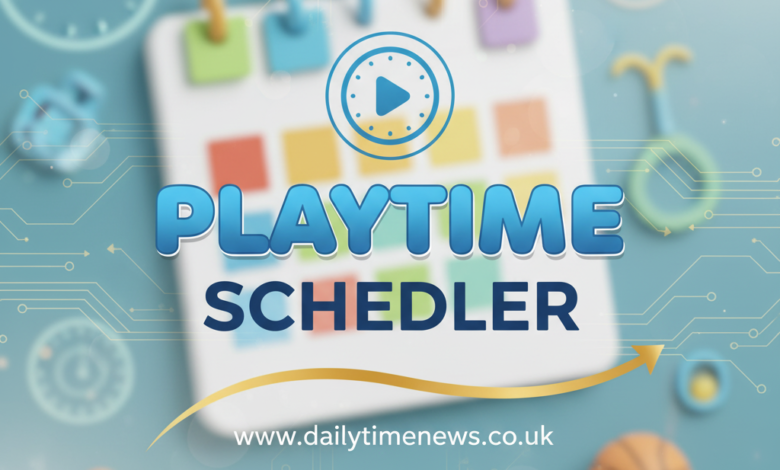Maximizing Fun and Productivity: The Ultimate Playtime Scheduler Guide

Introduction to Playtime Scheduling
Playtime Scheduler refers to the intentional organization of leisure activities, allowing individuals to allocate dedicated time for play. This concept has gained momentum in recent years as experts recognize the importance of play for people of all ages, including both children and adults. The idea stems from the understanding that play is not merely a pastime but a crucial component of a balanced and healthy lifestyle.
One of the primary benefits of utilizing a playtime scheduler is the positive impact it can have on mental well-being. Engaging in structured play can alleviate stress, reduce anxiety, and promote emotional regulation. For children, play serves as an essential medium for learning and development, while adults can find relaxation and rejuvenation through play, which subsequently leads to enhanced focus and productivity in their professional lives.
Additionally, structured playtime fosters creativity and problem-solving skills. By incorporating various play activities into a schedule, individuals can explore their interests more thoroughly and engage in new experiences that stimulate their creativity. As such, play is increasingly viewed as a developmental tool that nurtures critical thinking and innovation, making it a key element for success in personal and professional realms.
The recognition of play as a vital aspect of life necessitates the need for careful planning. By intentionally integrating play into daily routines, individuals can strike a balance between work obligations and leisure pursuits. This scheduling not only maximizes enjoyment but also ensures that playtime contributes meaningfully to personal growth and emotional resilience. In essence, the modern playtime scheduler is seen not just as a tool for organizing fun but as an essential framework for enhancing overall quality of life.
Understanding the Importance of Play
Play is a fundamental aspect of human existence, playing a critical role in both childhood development and adult wellness. For children, play serves as a primary vehicle for learning and growth. During these formative years, engaging in playful activities allows children to develop essential cognitive skills, such as problem-solving and critical thinking. The process of exploration, where children manipulate their environment and experiment with physical boundaries, promotes not only motor skills but also fosters creativity and imagination.
Research underscores the importance of play in children’s emotional and social development as well. Through play, children learn valuable interpersonal skills such as cooperation, negotiation, and empathy. These social interactions can help cultivate these young individuals’ ability to form and maintain relationships, skills which are crucial later in life. The use of a structured playtime scheduler can be beneficial in ensuring that children engage in a variety of play activities that promote diverse skills and emotional resilience.
For adults, play shifts from a focus on physical development to serving as a crucial stress-relief mechanism. Adult play encompasses leisure activities and hobbies that allow individuals to unwind and disconnect from daily pressures. Engaging in playful activities can lead to improved mental health, enhanced creativity, and greater overall life satisfaction. Additionally, as adults are often preoccupied with responsibilities, a playtime scheduler can help integrate leisure time into their busy lives, ensuring that they prioritize play and its associated benefits.
In summary, recognizing the significance of play extends beyond mere enjoyment; it is essential for healthy development across the lifespan. From cognitive and emotional growth in children to stress relief and relationship-building in adults, play remains a vital component of overall well-being. By effectively incorporating a playtime scheduler, individuals of all ages can harness the full potential of play in their daily lives.
Different Types of Play: Structured vs. Unstructured
Play is a fundamental aspect of childhood development, and it can be categorized into two primary types: structured and unstructured play. Understanding the differences between these playtypes is essential for effectively utilizing a playtime scheduler to accommodate diverse engagement opportunities while promoting overall growth.
Structured play is characterized by organized activities that often have set rules, objectives, and sometimes specific instructions. This type of play can be seen in team sports, board games, or organized educational programs. The advantages of structured play include the development of social skills through teamwork, enhanced problem-solving abilities, and increased physical coordination. Additionally, it can provide a sense of accomplishment as children complete tasks and achieve goals. However, some disadvantages may arise, such as increased pressure to perform and a potential lack of creativity due to rigid structures.
On the other hand, unstructured play is more organic and driven by the child’s imagination. This category includes free play, where children engage in activities without predefined rules or objectives. Unstructured play has numerous benefits, including fostering creativity, encouraging self-directed exploration, and allowing children to develop their interpersonal skills organically. However, some concern exists regarding potential safety issues and a lack of guidance, which can hinder skill acquisition if play is not appropriately supervised.
To create an effective playtime scheduler, it is crucial to incorporate a balanced mix of both structured and unstructured play. By providing opportunities for children to engage in both types, caregivers can enhance learning experiences while facilitating personal growth. For instance, alternating between structured games that develop particular skills and unstructured play that allows for free expression can maximize enjoyment and developmental benefits, enriching the overall playtime experience.
How to Create a Playtime Schedule
Creating an effective playtime schedule is essential for balancing fun and productivity in daily life. To begin, it is important to assess individual preferences and interests. Take the time to talk with those involved about their favorite activities. Whether it’s sports, arts and crafts, or outdoor explorations, understanding what everyone enjoys will inform the scheduling process. Consider using a simple survey or discussion to gather insights on preferences and availability.
Once preferences are clear, it is time to allocate specific time slots for playtime activities. Make a list of all the preferred activities and the time required for each. While some activities may only need 30 minutes, others may require up to several hours. It is vital to consider the everyday obligations of all participants, ensuring that the playtime schedule accommodates unavoidable commitments such as school or work. Establishing a routine can make this process easier, allowing for efficient use of time while still prioritizing fun.
Flexibility is a key component of any successful playtime scheduler. Life can be unpredictable, and interests may change over time. Therefore, it is crucial to allow room for spontaneous play and to adapt the schedule as needed. Consider designating a couple of open slots during the week for unplanned activities; this way, there is always an opportunity to explore new interests or revisit old favorites. Incorporating buffer time between scheduled activities can also help manage transitions and unexpected changes smoothly, while keeping the enjoyment high.
Ultimately, the goal of a playtime schedule is to ensure that time spent on leisure activities complements daily responsibilities and enriches the overall experience of life, blending fun and productivity seamlessly.
Tools and Resources for Playtime Scheduling
In the quest to maximize fun and productivity through effective time management, a variety of tools and resources are available for creating and managing a playtime scheduler. These innovative solutions cater to diverse demographics, ensuring that everyone can find a suitable approach to enhancing their leisure time. Among the most popular options are mobile applications, online platforms, and traditional physical planners.
Mobile applications have gained immense popularity due to their convenience and accessibility. Apps such as Google Calendar and Todoist offer flexible scheduling features that allow users to allocate time for play and leisure activities seamlessly. Additionally, dedicated playtime scheduler apps like Playtime Planner or FunTimer provide specialized functions designed solely for managing recreational activities. These tools enable users to set reminders, track duration, and even integrate with social media for coordinated playdates.
Online platforms also serve as excellent resources for scheduling leisure time. Websites like Trello and Asana can be customized to create visual boards that organize activities and responsibilities effectively. Users can categorize events by priority, helping to strike a balance between work and play. Moreover, several websites offer templates specifically tailored for scheduling playtime, making it easier to customize activities based on individual preferences.
Finally, traditional physical planners remain a timeless option for those who prefer a tangible approach to organizing their schedules. Bullet journals, for instance, provide creative freedom to design personalized pages dedicated to playtime activities. Utilizing color coding and visual elements can make planning more engaging, encouraging users to adhere to their schedules. By combining these various tools and resources, individuals can effectively tailor their playtime scheduler to meet their unique needs, ensuring a balanced and fulfilling lifestyle.
Incorporating Play into Daily Routines
Integrating play into daily routines can significantly enhance both productivity and well-being. Whether in a work environment, during school hours, or at home, establishing designated times for play enables individuals and families to experience the numerous benefits that play has to offer. A playtime scheduler can facilitate this process by creating structured intervals that prioritize fun while maintaining a balanced lifestyle.
In a work setting, it is essential to encourage regular breaks that include playful activities. For instance, team-building exercises or a five-minute game can invigorate employees, fostering creativity and collaboration. By introducing scheduled play breaks throughout the day, organizations can cultivate a more dynamic work environment. Utilizing a playtime scheduler to coordinate these breaks ensures that they are not overlooked amidst meeting agendas and deadlines, ultimately leading to improved morale and productivity.
In educational settings, teachers can also implement structured playtime into lesson plans. Activities such as interactive games or movement breaks can be incorporated into the daily schedule, allowing students to refocus and engage with the material better. A playtime scheduler that designates specific times for these activities can enhance attention spans and learning outcomes. Additionally, it promotes the idea that academic rigor can coexist with playful exploration, making the learning process more enjoyable.
At home, integrating play into family routines is equally important. Designating time for family games, outdoor activities, or creative projects can strengthen relationships and increase overall happiness. By using a playtime scheduler, families can prioritize these moments, ensuring that playful interactions become a consistent aspect of their daily life rather than an occasional occurrence. This approach not only enhances family bonding but also cultivates an atmosphere where everyone feels valued and connected.
Ultimately, adopting a structured approach through a playtime scheduler ensures that play is seamlessly woven into everyday life. Whether at work, school, or home, individuals and families can enjoy the benefits while still meeting their responsibilities.
The Role of Parents and Educators in Play Scheduling
In the realm of childhood development, the collaboration between parents and educators plays a crucial role in implementing an effective playtime scheduler. Parents are often the first influencers in a child’s life, instilling values and shaping behaviors around play. They can enhance the play experience by setting aside dedicated time for play and ensuring that children have access to appropriate resources and activities. By doing so, they help children establish a routine that aligns with their playtime scheduler, allowing for a balance between structured and unstructured play.
Educators, on the other hand, have the responsibility to create a learning environment that nurtures the importance of play. It is essential for educators to recognize that play is not merely a break from academic tasks; rather, it is a crucial component of the learning process. By integrating play into daily schedules, educators can promote collaborative play, which enhances social skills and teamwork among children. This collaborative element not only aligns with the playtime scheduler but also cultivates a spirit of cooperation and mutual respect.
Both parents and educators can encourage adherence to the scheduled playtime by using positive reinforcement. Celebrating children’s achievements related to play and providing feedback can reinforce the value of following the playtime schedule. Additionally, it is important to periodically evaluate the scheduling itself; both parents and educators should be open to feedback from children to adjust the playtime schedule, ensuring it meets their unique needs and fosters their creativity.
Moreover, creating a conducive environment is paramount for optimizing both structured and unstructured play. This includes providing safe spaces for exploration and materials that inspire imagination. By addressing these aspects, parents and educators forge a collaborative partnership that promotes not just adherence to a playtime scheduler but also enriches the overall play experience for children.
Monitoring and Evaluating Playtime Effectiveness
Effectively monitoring and evaluating the playtime scheduler plays a crucial role in maximizing fun and productivity. To assess the effectiveness of the scheduled play sessions, it is essential to establish criteria for evaluating engagement levels among participants. One approach is to observe attendance rates during scheduled activities; consistent participation suggests that the playtime activities resonate with the audience. Engaging activities tend to attract more participants, thereby indicating higher levels of interest.
Gathering feedback is another vital element in this process. Administering surveys or holding informal discussions can yield invaluable insights into how participants feel about the activities. Questions might include: “What aspects of playtime did you enjoy the most?” or “What would you like to see changed in the schedule?” Such feedback allows for the adaptation of the playtime scheduler to better align with participants’ interests and needs.
Furthermore, utilizing digital tools to monitor engagement can provide quantifiable data to assess how well each scheduled activity performs. Metrics such as the duration of participation, frequency of players’ involvement, or levels of enthusiasm captured through video recordings can offer comprehensive views of engagement trends. Evaluating this data will help in identifying what activities foster excitement and which ones may require reevaluation or modification.
Once sufficient data is collected, it becomes imperative to adjust the playtime schedule accordingly. If certain activities are receiving positive feedback while others are not, it may be beneficial to replace or modify the less successful elements. Such iterative adjustment ensures a playtime schedule that continually evolves to suit the preferences and engagement levels of the participants, ultimately creating a more enjoyable and productive environment.
Conclusion: The Balance of Play and Productivity
Achieving a harmonious balance between play and productivity is essential for a fulfilling and enriching life. The importance of incorporating structured playtime into our daily routines cannot be overstated. The playtime scheduler serves as a valuable tool in facilitating this balance, allowing individuals to allocate time to both work and leisure without compromising one for the other.
Throughout this guide, we explored the necessity of scheduling playtime as a means to enhance overall well-being. Engaging in play is not merely a leisure activity; it is a critical component that promotes creativity, improves mental health, and fosters social connections. By integrating periods of play into our productivity plans, we provide ourselves with the necessary breaks that enhance focus and efficiency. The brain functions better when it is allowed to rest and recharge, and playtime serves this purpose effectively.
Moreover, we discussed various strategies for creating a personalized playtime scheduler, which enables individuals to identify their unique needs and preferences. By taking the initial steps towards designing a play schedule that fits one’s lifestyle, it becomes possible to enjoy the full benefits of both play and productivity. As we strive for success in our respective endeavors, it is crucial to remember that productive work is complemented by periods of relaxation and enjoyment. Prioritizing playtime can ultimately lead to improved performance, increased motivation, and a greater sense of satisfaction in both professional and personal spheres.
In conclusion, establishing a balance between play and productivity is not just beneficial; it is essential. We encourage readers to take action by implementing their own playtime schedules, recognizing that a fulfilling life encompasses both productive pursuits and joyful experiences.
Also read on www.dailytimenews.co.uk



